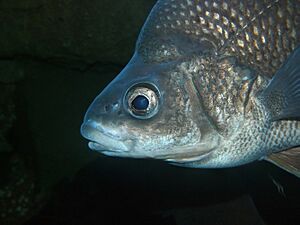Macquarie perch facts for kids
Quick facts for kids Macquarie perch |
|
|---|---|
 |
|
| Conservation status | |
| Scientific classification | |
| Synonyms | |
|
The Macquarie perch (Macquaria australasica) is a special freshwater fish that lives in Australia. You can find it in the Murray-Darling river system. It's part of the Percichthyidae fish family. This means it's a cousin to the golden perch. Its name comes from the Macquarie River, where it was first studied. Australasica means 'southern' in Latin.
Contents
About the Macquarie Perch
Macquarie perch are medium-sized fish. They are usually about 30–40 cm long. They weigh between 1.0 and 1.5 kg. The biggest ones can be about 50 cm long and weigh 2.5 kg.
Their bodies are long and flat on the sides. Their tail fin, bottom fin, and soft top fin are rounded. They have strong, spiny top fins. Their mouths and eyes are quite small. Their color can be tan, dark purplish-grey, or black. Their eyes have shiny silver centers.
What They Eat
Macquarie perch are peaceful fish. They mostly eat small water creatures. These include caddisfly, stonefly, and mayfly larvae. They also eat a few land insects.
Reproduction and Life Cycle
Macquarie perch mainly live in upland rivers and streams. Their breeding habits are perfect for these fast-flowing waters. It's hard to breed them in tanks because they need moving water.
They breed in late spring when the water is about 15 to 16 °C. They lay their eggs in flowing water over clean rocks and gravel. The eggs sink and get stuck in the spaces between the gravel. This protects them until they hatch. This is similar to how trout breed.
Female Macquarie perch grow bigger than males. They also become ready to breed when they are older and larger than males. Some Macquarie perch have lived for up to 20 years. They might live as long as their relatives, the golden perch, which can live for 26 years.
Where They Live
Macquarie perch used to live in the larger upland rivers and streams. These were in the south-eastern part of the Murray-Darling system. They often shared these places with trout cod and blackfish.
These fish show a pattern common in Murray-Darling fish. Some fish specialize in lowland areas, and others in upland areas. Macquarie perch are a special upland version of the golden perch. Golden perch mostly live in lowland areas. However, golden perch are very adaptable and can sometimes live in upland places too.
Macquarie perch are also found in rivers on the eastern coast, like the Shoalhaven and Hawkesbury-Nepean systems. This shows they crossed the Great Dividing Range long ago. This happened when rivers naturally connected. Scientists believe the Shoalhaven River population was the oldest. They moved to the Hawkesbury-Nepean system about 2 million years ago. Then, they moved into the Murray-Darling Basin about 657,000 years ago.
The fish in the eastern coastal rivers are smaller. They are usually 15 to 20 cm long. They also have one less bone in their spine than the Murray-Darling fish. The Shoalhaven population might be gone now. This is due to dams and other fish being put into their habitat. The Hawkesbury-Nepean population is also in danger. This is because of introduced trout and other fish, dams, pollution, and city growth. The information on this page is mostly about the Murray-Darling population.
There is a group of Macquarie perch that were moved to the Mongarlowe River. This river flows into the Shoalhaven. These fish are thought to be from the Murray-Darling Basin. This group seems to be shrinking and might disappear.
Another group of Macquarie perch was moved to the Yarra River near Melbourne. These fish are breeding and doing well. They are found in the middle and upper parts of the river.
Conservation Efforts
Macquarie perch in the Murray-Darling system are now listed as endangered. This means they are at high risk of disappearing forever. Many things have caused their numbers to drop.
Threats to Macquarie Perch
- Overfishing: Too many fish were caught by people fishing.
- Habitat Loss: Their homes are being damaged. This includes pollution from dirt and mud (siltation). Dams also change how rivers flow and make the water too warm.
- Diseases: A natural disease called EHN virus can kill Macquarie perch. This virus is now spread by introduced redfin perch.
- Introduced Fish: Brown trout and rainbow trout were brought into their habitats. These trout compete with Macquarie perch for food. They also eat young Macquarie perch. Scientists have seen that trout and Macquarie perch eat similar things.
Even in clean river areas, Macquarie perch populations have struggled. This is often because of introduced trout. Many of the last groups of Macquarie perch are in danger of disappearing in the next few decades.
It is hard to breed Macquarie perch in captivity. No Australian government groups are breeding many of them. Some groups even put introduced trout into rivers where Macquarie perch still live. This makes the problem worse. Rainbow trout can also carry the EHN virus, which harms Macquarie perch.



